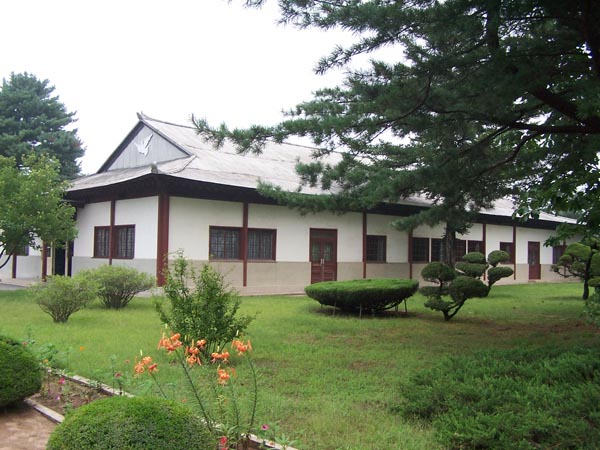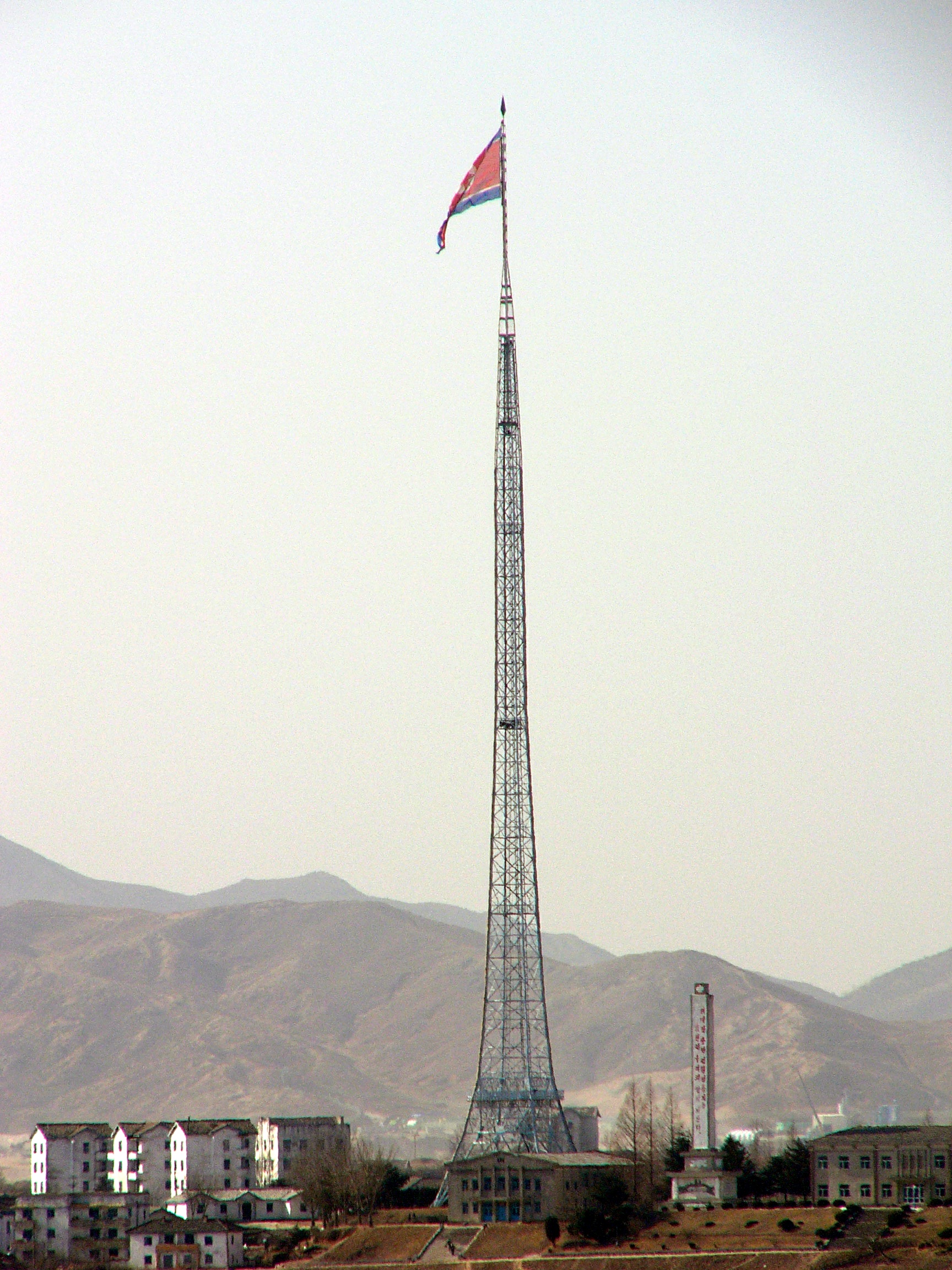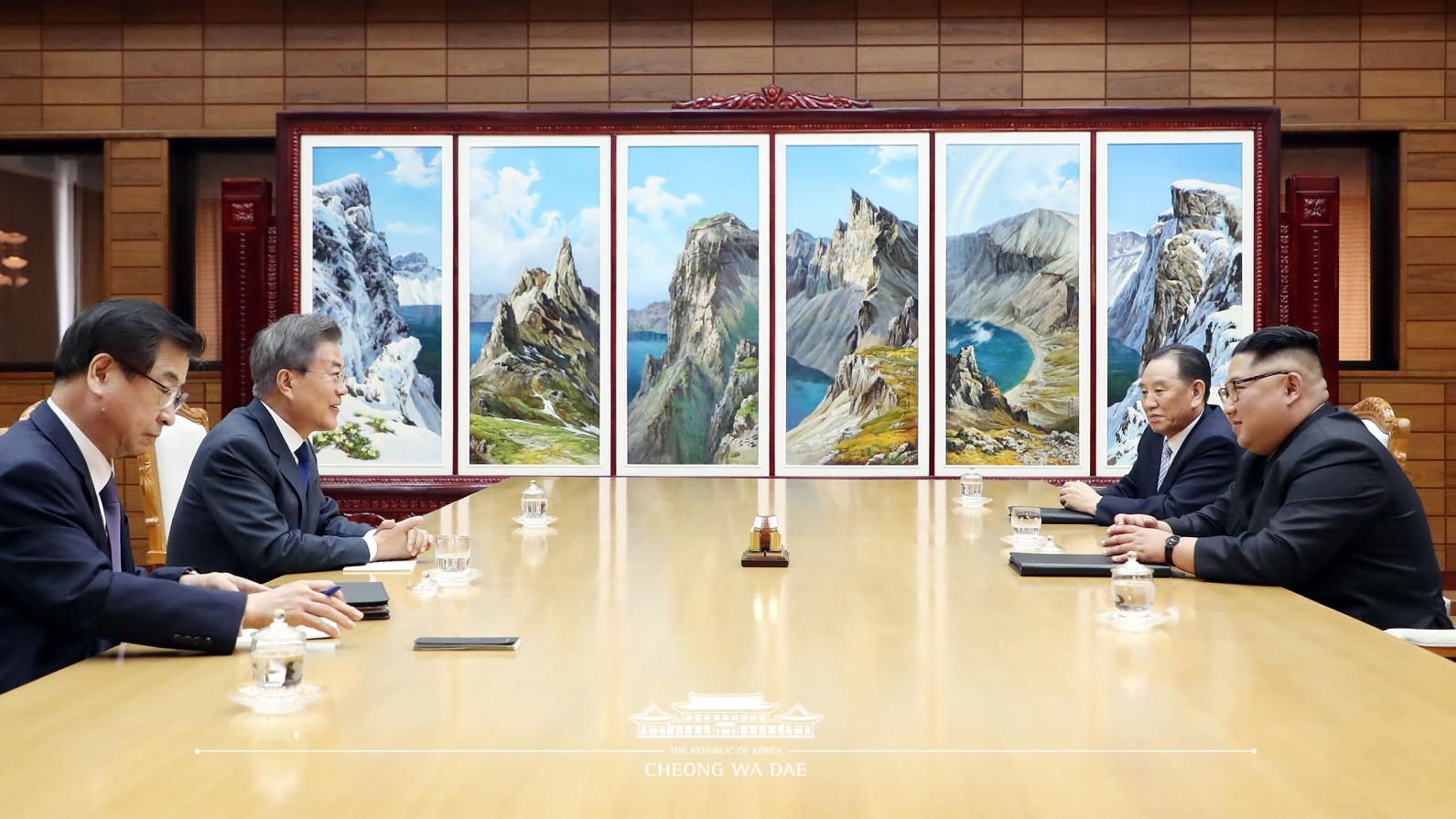|
Panmunjom
Panmunjom (also spelled Panmunjeom) was a village just north of the ''de facto'' border between North Korea and South Korea, where the 1953 Korean Armistice Agreement that ended the Korean War was signed. It was located in what is now Paju, Gyeonggi Province, South Korea, and Panmun-guyok, Kaesong, North Korea. The building where the armistice was signed still stands. Its name is often used as a metonym for the nearby Joint Security Area (JSA), where discussions between North Korea and South Korea still take place in blue buildings that straddle the Military Demarcation Line. As such, it is considered one of the last vestiges of the Cold War. Location The site of the former village is 53 kilometers north-northwest of the capital of South Korea, Seoul, and 10 kilometers east of Kaesong. The village, a small cluster of fewer than ten huts, is on the south side of the Kaesong-Seoul road on the west bank of the Sa'cheon stream. Meetings of the Military Armistice Commission took ... [...More Info...] [...Related Items...] OR: [Wikipedia] [Google] [Baidu] |
Joint Security Area
The Joint Security Area (JSA, often referred to as the Truce Village or Panmunjom) is the only portion of the Korean Demilitarized Zone (DMZ) where North Korea, North and South Korean forces stand face-to-face. The JSA is used by the two Koreas for diplomatic engagements and, until March 1991, was also the site of military negotiations between North Korea and the United Nations Command (UNC). The JSA has been the site of numerous events and incidents since its establishment in 1953, the first of which was the repatriation of Prisoner of war, prisoners of war (POWs) after the cessation of hostilities, across the Bridge of No Return. In 2018, North and South Korean officials agreed to clear the JSA of all landmines, weapons and guard posts. This withdrawal was complete on October 25, 2018, and the JSA now just contains 35 unarmed security guards. It was further agreed that henceforth, the area will serve mainly as a tourist attraction. On November 6, 2018, it was announced that th ... [...More Info...] [...Related Items...] OR: [Wikipedia] [Google] [Baidu] |
Korean Armistice Agreement
The Korean Armistice Agreement (; zh, t=韓國停戰協定 / 朝鮮停戰協定) is an armistice that brought about a cessation of hostilities of the Korean War. It was signed by United States Army Lieutenant General William Kelly Harrison Jr., William Harrison Jr. and General Mark W. Clark representing the United Nations Command (UNC), North Korea leader Kim Il Sung and General Nam Il representing the Korean People's Army (KPA), and Peng Dehuai representing the China, Chinese People's Volunteer Army (PVA). The armistice was signed on 27 July 1953, and was designed to "ensure a complete cessation of hostilities and of all acts of armed force in Korea until a final peaceful settlement is achieved." During the 1954 Geneva Conference in Switzerland, Chinese premier, Chinese Premier and foreign minister Zhou Enlai suggested that a peace treaty should be implemented on the Korean peninsula. However, the US secretary of state, John Foster Dulles, did not accommodate this attempt to ... [...More Info...] [...Related Items...] OR: [Wikipedia] [Google] [Baidu] |
April 2018 Inter-Korean Summit
The April 2018 inter-Korean summit took place on 27 April 2018 on the South Korean side of the Joint Security Area, between Moon Jae-in, President of South Korea, and Kim Jong Un, Chairman of the Workers' Party of Korea and Supreme Leader of North Korea. The summit was the third inter-Korean summit – the first in eleven years. It was also the first time since the end of the Korean War in 1953 that a North Korean leader entered the South's territory; President Moon also briefly crossed into the North's territory. The summit took place after the two sides had already held several meetings in preparation for their joint attendance at the 2018 Winter Olympics. The idea was initially brought forward through an official invitation from the North to conduct a meeting. The summit was focused on the North Korean nuclear weapons program and denuclearization of the Korean Peninsula. The Panmunjom Declaration was made following the summit. Agenda The two Koreas' high government offici ... [...More Info...] [...Related Items...] OR: [Wikipedia] [Google] [Baidu] |
Korean Demilitarized Zone
The Korean Demilitarized Zone () is a heavily militarized strip of land running across the Korea, Korean Peninsula near the 38th parallel north. The demilitarized zone (DMZ) is a border barrier that divides the peninsula roughly in half. It was established to serve as a buffer zone between the sovereign states of the North Korea, Democratic People's Republic of Korea (North Korea) and the South Korea, Republic of Korea (South Korea) under the provisions of the Korean Armistice Agreement in 1953, an agreement between North Korea, China, and the United Nations Command. The DMZ is long and about wide. There have been List of border incidents involving North and South Korea, various incidents in and around the DMZ, with military and civilian casualties on both sides. Within the DMZ is a meeting point between the two Korean states, where negotiations take place: the small Joint Security Area (JSA) near the western end of the zone. Location The Korean Demilitarized Zone inter ... [...More Info...] [...Related Items...] OR: [Wikipedia] [Google] [Baidu] |
Peace House
The Peace House (House of Peace or Home of Peace) is a venue for peace talks between North and South Korea. The building is situated in the Joint Security Area on the south side of the Military Demarcation Line bisecting the area. It is under the jurisdiction of the United Nations Command. The Peace House is a three-story structure built in December 1989, with construction completing on December 19, 1989. The floor layout, which adds up to , is as follows: *First floor: a pair of rooms used mainly for press conferences and lower-level meetings. *Second floor: dedicated, for the most part, to an elaborate conference room *Third floor: two rooms, one dedicated for luncheons and dinners The building is intended for non-military purposes, with the most notable usage being the April 2018 inter-Korean summit. The building is equipped with closed-circuit television and microphones, allowing real time audio and video monitoring of the facility at the South Korean presidential off ... [...More Info...] [...Related Items...] OR: [Wikipedia] [Google] [Baidu] |
Korean War
The Korean War (25 June 1950 – 27 July 1953) was an armed conflict on the Korean Peninsula fought between North Korea (Democratic People's Republic of Korea; DPRK) and South Korea (Republic of Korea; ROK) and their allies. North Korea was supported by China and the Soviet Union, while South Korea was supported by the United Nations Command (UNC) led by the United States. The conflict was one of the first major proxy wars of the Cold War. Fighting ended in 1953 with an armistice but no peace treaty, leading to the ongoing Korean conflict. After the end of World War II in 1945, Korea, which had been a Korea under Japanese rule, Japanese colony for 35 years, was Division of Korea, divided by the Soviet Union and the United States into two occupation zones at the 38th parallel north, 38th parallel, with plans for a future independent state. Due to political disagreements and influence from their backers, the zones formed their governments in 1948. North Korea was led by Kim Il S ... [...More Info...] [...Related Items...] OR: [Wikipedia] [Google] [Baidu] |
North Korea
North Korea, officially the Democratic People's Republic of Korea (DPRK), is a country in East Asia. It constitutes the northern half of the Korea, Korean Peninsula and borders China and Russia to the north at the Yalu River, Yalu (Amnok) and Tumen River, Tumen rivers, and South Korea to the south at the Korean Demilitarized Zone, Korean Demilitarized Zone (DMZ). The country's western border is formed by the Yellow Sea, while its eastern border is defined by the Sea of Japan. North Korea, like South Korea, claims to be the sole legitimate government of the entire peninsula and List of islands of North Korea, adjacent islands. Pyongyang is the capital and largest city. The Korean Peninsula was first inhabited as early as the Lower Paleolithic period. Its Gojoseon, first kingdom was noted in Chinese records in the early 7th century BCE. Following the unification of the Three Kingdoms of Korea into Unified Silla, Silla and Balhae in the late 7th century, Korea was ruled by the G ... [...More Info...] [...Related Items...] OR: [Wikipedia] [Google] [Baidu] |
Kijŏng-dong
Kijŏng-dong, Kijŏngdong, Kijŏng tong or Kaepoong is reportedly a Potemkin village in P'yŏnghwa-ri (), Panmun-guyok, Kaesong, Kaesong Special City, North Korea. It is situated in the North's half of the Korean Demilitarized Zone (DMZ). Also known in North Korea as ''Peace Village'' (),"APK İndirelim" November 12, 2006 it has been widely referred to as 'Propaganda Village' () by those outside North Korea, especially in South Korean and Western media. Kijŏng-dong is one of two villages permitted to remain in the wide DMZ set up under the Korean Armistice Agreement, 1953 armistice during the Korean War; the other is the South Korean village of Daeseong-dong, away. History [...More Info...] [...Related Items...] OR: [Wikipedia] [Google] [Baidu] |
United Nations Command
United Nations Command (UNC or UN Command) is the multinational military force established to support the South Korea, Republic of Korea (South Korea) during and after the Korean War. It was the first attempt at collective security by the United Nations (UN) after the Charter of the United Nations was signed. The UNC was established on 24 July 1950 following the United Nations Security Council's recognition, on 7 July, of North Korean aggression against South Korea. The motion passed because the Soviet Union, a close ally of North Korea and a member of the UN Security Council, was boycotting the UN at the time over its recognition of the Taiwan, Republic of China (Taiwan) rather than the China, People's Republic of China. Member states of the United Nations, UN member states were called to provide assistance in repelling the North's invasion, with the UNC providing a cohesive command structure under which the disparate forces would operate. During the course of the war, 22 n ... [...More Info...] [...Related Items...] OR: [Wikipedia] [Google] [Baidu] |
May 2018 Inter-Korean Summit
The May 2018 inter-Korean summit was the second inter-Korean summit in 2018. On 26 May, North Korean state chairman Kim Jong Un and South Korean president Moon Jae-in met again in the joint Security Area, this time on the North Korean side in the Inter-Korean Peace House in the Unification Pavilion. The meeting took two hours, and unlike other summits it had not been publicly announced beforehand. Photos released by South Korea's presidential office showed Moon arriving at the northern side of the Panmunjom truce village and shaking hands with Kim's sister, Kim Yo Jong, before sitting down with Kim for their summit. Moon was accompanied by Suh Hoon, Director of the National Intelligence Service of South Korea, while Kim was joined by Kim Yong-chol, a former military intelligence chief who is now a vice chairman of the North Korean ruling party's central committee tasked with inter-Korean relations. The meeting was largely centered around North Korean leader Kim Jong Un's ... [...More Info...] [...Related Items...] OR: [Wikipedia] [Google] [Baidu] |
North Korea Peace Museum
The North Korea Peace Museum is in the building constructed to house the signing of the Korean War Armistice Agreement on 27 July 1953. It is located in the former village of Panmunjeom (Phanmunjŏm) in North Hwanghae Province, North Korea. It is located approximately northwest of the Joint Security Area (JSA), in the northern half of the Demilitarized Zone. The building is all that remains of the former village, and since the mid-1950s, references to Panmunjom actually refer to the Joint Security Area itself. It is about northeast of Kijong-dong, often referred to as ''Propaganda Village''. The weapons used to kill U.S. Army Captain Arthur Bonifas and Lieutenant Mark Barrett in the axe murder incident of 1976 are housed within the museum. There is a symbol of a dove above the door. At the time of the signing of the armistice, a copy of Pablo Picasso's ''Dove'' was hanging inside the building. Because Picasso was a communist, the Americans considered it a symbol of commu ... [...More Info...] [...Related Items...] OR: [Wikipedia] [Google] [Baidu] |
United Nations Command Military Armistice Commission
The United Nations Command Military Armistice Commission (UNCMAC) was established in July 1953 at the end of the Korean War. The mission of UNCMAC is to supervise the Military Armistice Agreement between the two Koreas along the 151 mile Demilitarized Zone (DMZ). UNCMAC is headquartered in Seoul and Panmunjom. History Between 1950 and 1953 a coalition of forces from 21 nations fought to preserve the sovereignty of the Republic of Korea (ROK), following the invasion by the Democratic People's Republic of Korea (DPRK) under the United Nations flag in the Korean War. The Korean War did not result in a decisive victory for either side; instead an Armistice Agreement was signed in 1953, bringing the active conflict to a close. The United Nations Command, established under the mandate of UN Security Council Resolution 83 and Resolution 84, represented the world's first attempt at collective security. The parties to conflict established the Military Armistice Commission (MAC) t ... [...More Info...] [...Related Items...] OR: [Wikipedia] [Google] [Baidu] |





